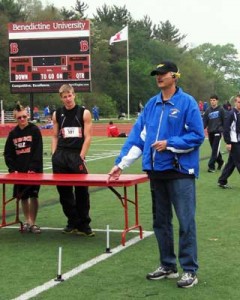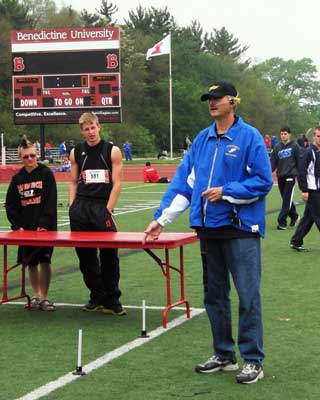
It is relatively common to measure and assess the 10 meter splits of elite 100 meter sprinters at large track meets. Track coaches analyze this data to gain insight into how to train for and how to best run the 100 meter sprint with the goal of minimizing the sum of the ten splits.
Lisle High School Track Coach Ken Jakalski wanted to measure the 10 meter splits of high school athletes while competing in a track meet, and he was granted permission to use the Freelap Timing System to acquire 10 meter splits at the 2012 Carlin Nalley Track and Field Invitational. Freelap USA representative Christopher Glaeser attended the invite to provide equipment and assist with the setup and data acquisition.
Prior to the meet, 10 meter chalk marks were placed on the track between lanes five and six using a track measuring wheel. When it was time to run the 100 meters finals, Freelap TX Junior transmitters were placed on each of the chalk marks. A Freelap watch and sprint belt was worn by each of the top two seeds in the 100 meter finals. The table below includes the splits for the ten segments and the total for each athlete.
1 |
2 |
3 |
4 |
5 |
6 |
7 |
8 |
9 |
10 |
Total |
1.98 |
1.16 |
1.06 |
0.99 |
0.96 |
1.01 |
1.03 |
0.97 |
1.02 |
1.03 |
11.21 |
1.79 |
1.21 |
1.10 |
1.04 |
1.03 |
1.06 |
1.08 |
1.03 |
1.12 |
1.17 |
11.63 |
It is noteworthy that the speed curves for both high school sprinters are quite different from an elite sprinter. In particular, we would expect an elite sprinter to have an acceleration phase, maximum velocity phase, followed by a deceleration phase. As can be seen in the table above, both of the top seed sprinters at this high school invite had two distinct accelerations and deceleration phases. Both athletes hit a plateau in the fifth and then again in the eighth segments.
This leads to several questions. How common is this two-phase acceleration / deceleration among high school and collegiate athletes? And, more important, is it possible to use this information to train these athletes to run more efficient races with improved times?
Special thanks to Ken Jakalski and the timing staff at Lisle High School for conceiving and organizing this timing experiment.
Please share this article so others may benefit.
[mashshare]


Did these times include reaction time? If not I’m curious what the FAT time was considering reaction time would be padded on.
I find these results interesting and I had the same question as Kyle. But I looked up the results of the meet, and it looks like this is supposed to include reaction time… meaning Evans, the third place guy, allegedly ran a 7.23 60 meter en route to 11.63. That sounds really fishy, as a 7.23 will generally get you something in the 11.1s to 11.2s.
Even fishier is his 1.79 for his first 10; http://myweb.lmu.edu/jmureika/track/splits/splits.html
He’d be the fastest starter of all time (even assuming a perfect 0.10 reaction time, he’s covering the first ten meters in at most 1.69 second).
I like what I’ve seen from Freelap, but this discrepancy makes me think these splits are flawed. Maybe repeat the experiment at another meet this year and compare?
After going through my tables, it looks like the second ten meter interval is about what you’d expect for athletes of this level – 1.21 for the 10-20 meter segment is consistent with someone running an 11.58-11.70, which is what our 2nd seed did here. 1.16 is consistent with a time of 11.13-11.24, which is what our first seed did.
There MUST have been something in the timing of the first ten meters. The remaining splits all look pretty normal…except the “reacceleration” phase. This “dual plateau” puzzle may be explained by the same, or a similar, timing error, as it’s not reflected in the surrounding splits. Such a sudden change in velocity (Guy #1 goes from 9.7 m/s to 10.3 m/s to 9.8 m/s) after a 20 meters of predictable deceleration doesn’t make sense. I think what really happened is more likely that Guy #1 actually (a) started slower, then (b) hit a slightly higher top split from 40-50, then (c) slowed down in a conventional fashion for the next 50 meters.
I highly recommend FreeLap for anyone out there reading, and I’ve had nothing but good experiences with it, as I said above. But I think the starts and “dual plateau” here are flawed and wouldn’t want coaches to center their training around these putative results.
To get an accurate timing of the first 10 meters, you would have to place the sensor at 10 meters 80 cm. If they placed the first one at 10 meters that would explain the fast start.